ODATA topics necessary for SAP Ui5 / FIORI
.png)
The main purpose of OData services is to implement ‘Database Functionalities’. Types of OData services :- ODATA ABAP Service :- Interact with backend system of ( SAP ECC/CRM/SRM/SCM ) ODATA HANA Service :- Interact with backend system ( SAP HANA ). ODATA External Services :- Interacts with backend system ( Non SAP system ). ODATA ABAP Service :- These OData services are mainly executed under SAP NetWeaver gateway component with database operations ( Select, Insert, Delete, Update ). SAP NetWeaver gateway support two formats mainly XML format JSON format ( preferred because it is a light wight format ) From frontend if we indicate format with xml then SAP NetWeaver gateway component will hold the data under entity set in XML format. Suppose, we have this employee Data 1001 Vijay 34 XML format JSON Format Advantages of OData Services :- OData services are independent of frontend, these can be accessed in various front end apps like SAP Ui5 or FIORI, .NE...
.png)
.png)
.png)
.png)
.png)
.png)